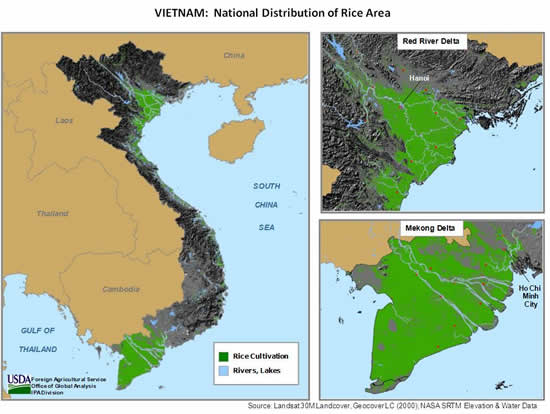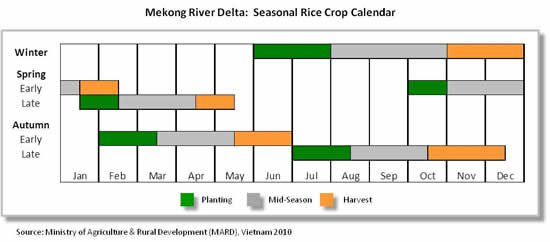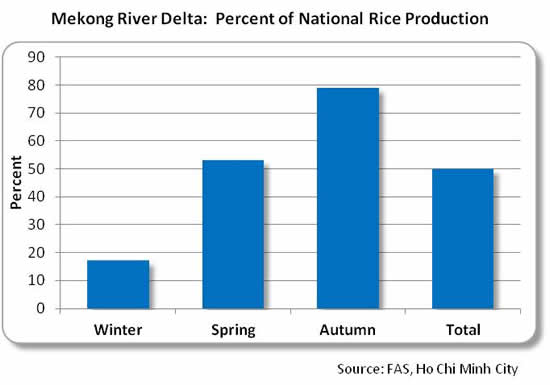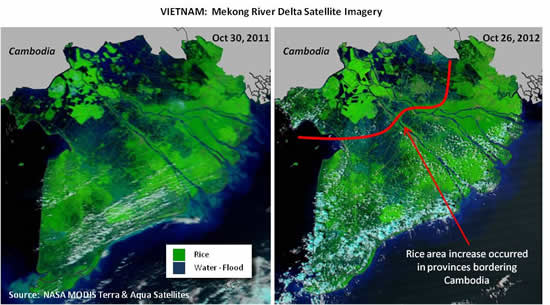VIETNAM: Record Rice Production Forecast on Surge in Planting in Mekong Delta
The USDA forecast Vietnam’s 2012/13 milled rice production at a record 27.7 million tons, up 0.6 million or 2 percent from last month and last year. National rice area was also forecast at a record 7.8 million hectares, up 0.2 million or 2 percent from last month and up 1 percent from last year. Crop yield was estimated unchanged at a record 5.66 tons per hectare. The overall increase in rice production this month was attributed to unusually large increases in seasonal rice area in southern Vietnam’s Mekong River Delta (MRD). Rice farmers reportedly took advantage of lower than normal floodwaters in October to plant extra acreage on lands normally submerged at that time of year.

The Mekong River Delta in southern Vietnam is a vast alluvial plain formed over the millennia from silt deposited by the floodwaters of the world’s 12th longest river, which also ranks in the top ten rivers in terms of total water discharge and sediment load. The Mekong River itself is 2,700 miles long, stretching from the Tibetan Plateau in China to the South China Sea in southern Vietnam. It drains an area equivalent to 313,000 square miles of land along its path. Vast areas of the MRD experience flooding on an annual basis, as a result of heavy monsoonal rainfall in the upper Mekong River catchment. The topography of the region is extremely flat, with most areas lying just above sea level (0.7-1.2 meters in height).
The MRD is a veritable rice growing paradise of ample rainfall (1800mm or 72 inches per year), tropical temperatures, and fertile soils. Add to this the vast dyke and irrigation infrastructure built by the Vietnamese, and you have a nearly perfect agricultural environment for continuous year-round rice cultivation. The development of irrigation systems has been greatly enhanced in the past 40 years with a network currently estimated at 30,000-40,000 kilometers of inter-connected canals within the MRD alone. Nationwide, the FAO (Aquastat) estimates that fully 97 percent of all land sown to rice in Vietnam is irrigated. Farmers in the MRD region cultivate 3 crops of rice each year, divided into winter, spring, and autumn seasonal periods. Total rice production currently averages about 15.3 million tons (milled basis), with the spring crop being the largest (6.75 million tons) followed by the autumn (5.75 million) and the winter crop (0.54 million tons).

The MRD is Vietnam’s most important rice growing region, contributing 50 percent of total national rice production. As far as seasonal rice crops are concerned the MRD is the country’s largest producer of both spring and autumn rice, contributing 53 and 79 percent of national output respectively. The country’s important rice export sector is also centered here, with 90 percent of total milled rice exports originating from this region. Vietnam is the world’s second largest rice exporting nation, following Thailand, and is estimated to have exported a record 7.4 million tons of rice in 2011/12; it is forecast to export another 7.0 million tons in 2012/13. Rice is the staple food in Vietnam, and it is cultivated on the vast majority of agricultural land. FAO estimates that rice is sown on 75-85 percent of the country’s total arable land area. Though per capita rice consumption has been falling in recent years owing to a growing economy and rising incomes, the government has been determined to continue to increase annual rice production to ensure domestic food security while also supporting a large export industry - which brought in nearly US$4 billion last year. Vietnam’s population is growing by a factor of approximately 1.0 million people per annum, and thus total rice demand is actually increasing despite falling per capita consumption.

In the last several years the government has provided financial support to farmers in the MRD to reinforce or increase the height of existing dykes and build new ones for enhanced seasonal flood control. It set a target of increasing the acreage sown to late autumn rice by 100,000 hectares through improved flood protection, with an expectation of increasing rough (paddy) rice output by 1.0 million tons. Recent statistics from the country’s Ministry of Agriculture and Rural Development (MARD) indicate that rice area in 2011/12 actually increased 135,000 hectares during the spring and autumn growing seasons, while an additional 100,000 hectares is forecast for 2012/13. Rough rice production also reportedly increased by 1.13 million tons in 2011/12 owing to expanded area in the MRD, while it is forecast to increase by another 1.0 million tons in 2012/13 for the same reason.

The government’s program to increase rice acreage by protecting larger land areas from seasonal flooding is apparently succeeding. Typically half of all available rice lands in the MRD are submerged by floodwaters during the period in which the late autumn crop is sown (July/August). FAS - Ho Chi Minh City reported that owing to a combination of low seasonal floods brought about by below normal monsoon rains this summer over Laos and northeastern Thailand (upper Mekong River region) and improved dyke construction, about 105,000 hectares of additional land was able to be sown to the late autumn rice crop. The area increase occurred primarily in provinces bordering southern Cambodia, as seen in the MODIS satellite images above. The provinces which contributed to this area expansion were An Giang (60,000 hectares), Dong Thap (25,000 hectares), Long An (20,000 hectares), and Ben Tre (5,000 hectares). It was also reported that historically farmers in both Long An and Ben Tre had never been able to cultivate rice during the late autumn period, owing to excessive flooding. Now they have an opportunity to increase local production and income, by cultivating rice during a season when local market prices are typically the highest.
Current USDA area and production estimates for grains and other agricultural commodities are available on IPAD's Agricultural Production page or at PSD Online.
|

